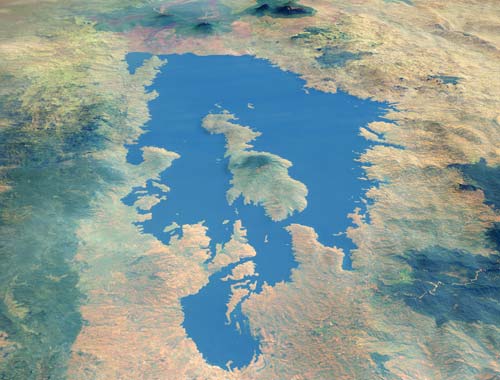Underwater power plant in Rwanda
Rwanda is endowed with a huge energy source at the bottom of Lake Kivu in the west of the country. Over millions of years of geological transformation, Lake Kivu currently contains dissolved methane gas estimated at 55 billion cubic meters at a depth of 600 m. With such a large amount of methane, Lake Kivu can meet Rwanda's energy needs for 200 years.
Currently, many companies are seeking to " harvest " this gas. One of them, Eco Energy, is preparing to sign a contract with the Rwandan government to get methane out of the lake and set up a power generation system. The process of releasing methane is not too complicated and can be summarized as follows: bringing water near the deep lake bottom to a depth of about 70m.
At this depth, water pressure decreases so methane gas easily escapes the water. Other gases such as carbon dioxide (CO2) and hydrogen sulphide are still dissolved in water and then pumped back to the depth at first to accumulate with methane gas. Meanwhile, methane gas, after being released from the bottom of the lake, is collected into the storage and use pipeline. Eco Energy said it will exploit methane gas with a purity of about 95%.

Lake Kivu was taken from NASA by NASA (Photo: NASA)
Scientists note that although it is a relatively clean and renewable energy, methane is a powerful greenhouse gas (if released into the environment in a natural way), with a higher level of harm to the environment. CO 2 at least 20 times. So the exploitation of this gas in Lake Kivu will be very useful for the environment, especially preventing the ' bomb bomb ' disaster that happened in Cameroon's Lake Nyos in 1986, killing 1,700 people.
Gases of methane and CO 2 accumulate large volumes under the lake, instead of slowly escaping to the air, the huge mass of gas suddenly releases from the water causing a big explosion. Because methane is heavier than air, oxygen is pushed out and all life in the lake area suffocates. Lake Kivu is hundreds of times bigger than Lake Nyos so if a similar disaster occurs, the number of casualties will surely reach millions.
It is estimated that tens of billions of cubic meters of methane in Lake Kivu, which has a surface area of 2,700 square kilometers, will ensure energy for Rwanda, limit dependence on petrol and significantly reduce the situation of deforestation for timber. fuel. In addition, Rwanda can export this vast resource to neighboring countries such as Uganda in the North and Congo Democratic Republic in the West.
- Producing electricity from death lake
- He built the first new generation nuclear power plant
- Japan built a new nuclear power plant in Aomori
- Russia is committed to building safe nuclear power for Vietnam
- It takes 40 years to close Japanese nuclear power plant
- Solar plant operates at night
- Fukushima nuclear plant lost power due to ... mouse
- Unique power plant shaped wine glasses
- Opening Australia's largest solar power plant
- The world's largest solar power plant comes into operation
- Scotland built a kite-powered power plant
- Operating the world's largest solar power plant
 Is the magnetic North Pole shift dangerous to humanity?
Is the magnetic North Pole shift dangerous to humanity? Washington legalizes the recycling of human bodies into fertilizer
Washington legalizes the recycling of human bodies into fertilizer Lightning stone - the mysterious guest
Lightning stone - the mysterious guest Stunned by the mysterious sunset, strange appearance
Stunned by the mysterious sunset, strange appearance